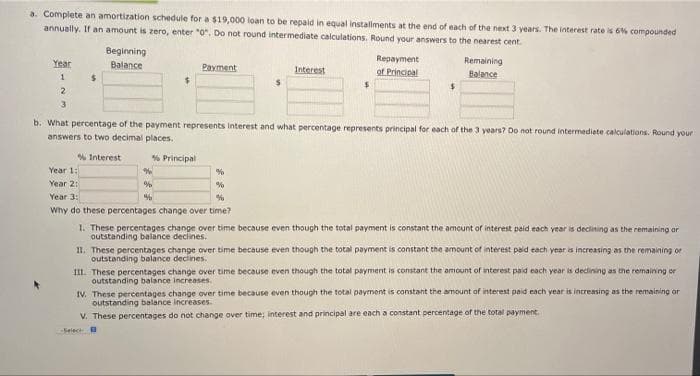a. Complete an amortization schedule for a $19,000 loan to be repaid in equal installments at the end of each of the next 3 years. The interest rate is 6% compounded annually. If an amount is zero, enter "0". Do not round intermediate calculations. Round your answers to the nearest cent Beginning Balance Payment Year 1 $ Repayment of Principal Remaining Balance Interest $ 2 3 b. What percentage of the payment represents interest and what percentage represents principal for each of the 3 years? Do not round intermediate calculations. Round your answers to two decimal places. % Interest % Principal Year 1: % Year 2: % Year 3: % Why do these percentages change over time? 1. These percentages change over time because even though the total payment is constant the amount of interest paid each year is declining as the remaining or outstanding balance declines. II. These percentages change over time because even though the total payment is constant the amount of interest paid each year is increasing as the remaining or outstanding balance declines. III. These percentages change over time because even though the total payment is constant the amount of interest paid each year is declining as the remaining or outstanding balance increases. IV. These percentages change over time because even though the total payment is constant the amount of interest paid each year is increasing as the remaining or outstanding balance increases. V. These percentages do not change over time; interest and principal are each a constant percentage of the total payment.
a. Complete an amortization schedule for a $19,000 loan to be repaid in equal installments at the end of each of the next 3 years. The interest rate is 6% compounded annually. If an amount is zero, enter "0". Do not round intermediate calculations. Round your answers to the nearest cent Beginning Balance Payment Year 1 $ Repayment of Principal Remaining Balance Interest $ 2 3 b. What percentage of the payment represents interest and what percentage represents principal for each of the 3 years? Do not round intermediate calculations. Round your answers to two decimal places. % Interest % Principal Year 1: % Year 2: % Year 3: % Why do these percentages change over time? 1. These percentages change over time because even though the total payment is constant the amount of interest paid each year is declining as the remaining or outstanding balance declines. II. These percentages change over time because even though the total payment is constant the amount of interest paid each year is increasing as the remaining or outstanding balance declines. III. These percentages change over time because even though the total payment is constant the amount of interest paid each year is declining as the remaining or outstanding balance increases. IV. These percentages change over time because even though the total payment is constant the amount of interest paid each year is increasing as the remaining or outstanding balance increases. V. These percentages do not change over time; interest and principal are each a constant percentage of the total payment.
Chapter19: Lease And Intermediate-term Financing
Section: Chapter Questions
Problem 17P
Related questions
Question

Transcribed Image Text:a. Complete an amortization schedule for a $19,000 loan to be repaid in equal installments at the end of each of the next 3 years. The interest rate is 6% compounded
annually. If an amount is zero, enter "0". Do not round intermediate calculations. Round your answers to the nearest cent
Beginning
Balance
Year
Payment
Repayment
of Principal
Remaining
Balance
Interest
1
$
2
3
b. What percentage of the payment represents interest and what percentage represents principal for each of the 3 years? Do not round intermediate calculations. Round your
answers to two decimal places.
% Interest
% Principal
Year 1:
%
%
Year 2:
%
%
Year 3:
%
%
Why do these percentages change over time?
1. These percentages change over time because even though the total payment is constant the amount of interest paid each year is declining as the remaining or
outstanding balance declines.
II. These percentages change over time because even though the total payment is constant the amount of interest paid each year is increasing as the remaining or
outstanding balance declines.
III. These percentages change over time because even though the total payment is constant the amount of interest paid each year is declining as the remaining or
outstanding balance increases.
IV. These percentages change over time because even though the total payment is constant the amount of interest paid each year is increasing as the remaining or
outstanding balance increases.
V. These percentages do not change over time; interest and principal are each a constant percentage of the total payment.
-Select
Expert Solution
This question has been solved!
Explore an expertly crafted, step-by-step solution for a thorough understanding of key concepts.
This is a popular solution!
Trending now
This is a popular solution!
Step by step
Solved in 4 steps with 4 images

Knowledge Booster
Learn more about
Need a deep-dive on the concept behind this application? Look no further. Learn more about this topic, accounting and related others by exploring similar questions and additional content below.Recommended textbooks for you

EBK CONTEMPORARY FINANCIAL MANAGEMENT
Finance
ISBN:
9781337514835
Author:
MOYER
Publisher:
CENGAGE LEARNING - CONSIGNMENT

Cornerstones of Financial Accounting
Accounting
ISBN:
9781337690881
Author:
Jay Rich, Jeff Jones
Publisher:
Cengage Learning

Intermediate Financial Management (MindTap Course…
Finance
ISBN:
9781337395083
Author:
Eugene F. Brigham, Phillip R. Daves
Publisher:
Cengage Learning

EBK CONTEMPORARY FINANCIAL MANAGEMENT
Finance
ISBN:
9781337514835
Author:
MOYER
Publisher:
CENGAGE LEARNING - CONSIGNMENT

Cornerstones of Financial Accounting
Accounting
ISBN:
9781337690881
Author:
Jay Rich, Jeff Jones
Publisher:
Cengage Learning

Intermediate Financial Management (MindTap Course…
Finance
ISBN:
9781337395083
Author:
Eugene F. Brigham, Phillip R. Daves
Publisher:
Cengage Learning

Principles of Accounting Volume 1
Accounting
ISBN:
9781947172685
Author:
OpenStax
Publisher:
OpenStax College


Intermediate Accounting: Reporting And Analysis
Accounting
ISBN:
9781337788281
Author:
James M. Wahlen, Jefferson P. Jones, Donald Pagach
Publisher:
Cengage Learning